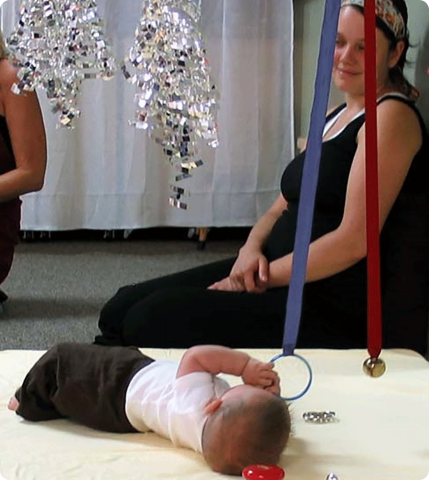Activities: Birth to 5 Months
Very young babies have got so much going on! It doesn't always appear to be that way from our perspective, but by the time your baby is 3 months old, their brain will have grown over 60% from the size it was when they were born. It is experience which builds baby's brains and so providing your baby with the sensorial, social and movement experiences they need will support this amazing spontenous process.
Activity Mat (From Birth)
Place a thin mat for movement on the floor in any place where your baby spends time. If you choose a neutral coloured cover rather than one which is highly coloured and patterned, your baby will be able to see the toys and objects you place on it more clearly.
By spending time watching your baby's movements will help you to understand exactly what area of movement development your baby is working on. The more time they have to move, the more they will repeat the same movement patterns. The opportunity for repetition helps your baby to learn. When your baby is ready for a change, they will let you know!
Low Mirror (from Birth)
A long low mirror placed alongside the play mat will enable your baby to watch their body move. They will see the results of their efforts as they practise their new movements. Watching themselves in the mirror also enables young babies to build their 'Body Scheme'. This is your baby's growing awareness of their body and the relationship of body parts to one another. It is the growing understanding of the difference between themselves and the world around them.
Young babies find mirrors very engaging. You might be surprised by how happy is playing in front of the mirror. These moments of concentration are highly signficant for your baby's brain development. You can help to maintain them by allowing your baby to explore the mirror without interruption. When your baby wants to reconnect with you or is ready for a change, they will make eye contact with you and vocalise.
Video: Baby playing with a low mirror
Low Bed (from 4 months)
A low bed is simply a shallow (11cms) single mattress or futon placed on the floor. It provides a place where your baby can see the world without the obstruction created by the bars of a cot. Using a low bed from 4 months means that as your child's movement possibilities increase, they can move freely and get up and put themselves to sleep when their natural rhythm tells them to do so.
Guidelines for safe sleeping on a low bed:
- sleep Baby on the back, not on the tummy or side;
- if using blankets, place Baby’s feet centrally at the bottom edge of the mattress with their face and head uncovered, ensure that blankets are securely tucked in;
- place the low bed in the same room as the parents for the first six to twelve months of life;
- place the low bed well away from walls – do not push the low bed up against the wall as this can cause entrapment hazards;
- keep the low bed away from all hazards e.g. no finger traps (holes or spaces 5-12 mm wide); no arm or leg traps (holes or spaces 30-50 mm wide); head traps (gaps wider than 85 mm); no protrusions, sharp points or edges; cords and cables.
- do not place anything on or alongside the low bed e.g. pillows, cushions or toys;
- ensure that electrical sockets are covered;
- provide stable shelving and furniture that cannot be pulled over.
Placing a few of your babys toys and books on low shelves near the low bed, will provide an incentive to move.
The transition from bassinet to low bed may take time. If your baby isn't ready to sleep they may cry or crawl out of bed and play with their toys. Consistency in your approach that the low bed is the place where they sleep will mean that eventually your baby will start to put themselves to sleep when they are tired. When your baby has had enough sleep, they will get up and play happily.
Mobiles
Hanging a mobile in your baby's play area can be a great way to support them to practice focusing upon and following an object with their eyes. They look fantastic too! Very young babies only see contrasts in light and dark initially, so black and white mobiles are ideal. Young babies actually prefer to look at dark circles. This is a pre-programed survival behaviour to enable your baby to find the nipple and food! You can use this preference to stimulate their visual sense. Be sure to keep the mobile just out of reach to remove the risk of entanglement, but close enough for them to be able to focus - they can see up to about 30 centimetres, but need practice focusing.
By 2-4 months your baby will start to be able to see colours, blue and yellow come first and then a month or so later, red and green. Simple mobiles with bright primary coloured shapes will be sure to entrance your baby. Their binocular vision will also establish at this time and with this ability to focus will come an appreciation of colour gradiation. Whilst your baby is still unable to grasp, these mobiles can still be placed just out of reach. Mobiles with objects which naturally move in the air such as birds, insects and hot air balloons will provide your baby with information about the real world.
Suggested mobiles:
- Munari - black and white geometrical shapes (4 objects)
- Octahedrons - Blue, yellow, white/black (3 objects)
- Gobbi - Spheres - 3-5 gradations of one primary colour (3-5 objects)
- Stylised paper figures - dancers (4 objects)
Once your baby is grasping intentionally they will attempt to use their hands to interact with the mobile. Choosing mobiles which are designed to be batted, grasped and shaken will meet this need.
Suggested mobiles:
- Stylised wooden figures (batting)
- Three coloured spheres (grasping)
- Bell on a ribbon
- Disc on a ribbon
Video: Young baby playing with a mobile
Toys
All toys have a developmental purpose. If you watch you baby for information about the areas of development they are working on, this will give you information about which toys might engage them. Toys that isolate a single area of development e.g. challenging the grasp, tend to hold a baby's focus for longer. Then once your baby has made that developmental acquisition they will want to move onto something else! Sometimes the toy your baby needs, is not that attractive to us as an adult. This can work the other way around as well. Something that we think looks incredible, may simply overwhelm a young baby and fail to engage them.
Young babies only need to be given 1 or 2 items at a time. Any more than this can lead to confusion or distraction and your baby won't have the full opportunity to explore the toy you have given them.
From 2 months
Rattles will stimulate your baby's auditory sense and provide a challenge to their grasp. The rattle will need to have parts which are small enough to fit into their tiny palm, and be light enough to remain in your baby's grasp. They also need to have a rounded shape so that when your baby brings their hand towards their face and eyes, the toy will not injure them. Toys made from natural materials will provide your baby with a more rich sensory experience than plastic items.
Initially you will have to place the toy in your baby's palm to stimulate the grasp reflex. Your baby will not have control over whether they release the object.
Suggested rattles:
- Cylinder Rattle with Bells
- Bamboo Cylinder Rattle
- Cube with Bell
- Bells on a Leather Strap
- Silver Rattle
Musical boxes are also wonderful toys at this stage of your baby's development. If you are able to find one which can be started by your baby once they are sitting, they will eventually be able to give themselves the experience.
From 3 months
As the control of their arms and hands increases, your baby will reach for objects of interest. If you offer your baby an object now, they may be able to reach and grasp it. Your baby will be able to hold toys with more complex shapes. You might also try placing them on the play mat just out of your baby's reach, this can provide encouragement to roll!
Suggested toys:
- Interlocking circles
- Grasping beads
- Teething ball
- Interlocking rings
- Small simple rattles made of natural materials
From 4 months
Your baby's eye-to-hand co-ordination is developing with every passing day and their grasp may have started to refine. They will find simple objects from your home fascinating to explore with their eyes, hands and mouth. These objects should have smooth edges and parts, without risk of finger (or tongue!) traps or entanglement. Ideally they will be made of natural materials. If you place the objects on the playmat, you will encourage your baby to reach and perhaps roll in order to grasp them.
Suggested objects:
- honey dipper
- bangle
- clothes peg

